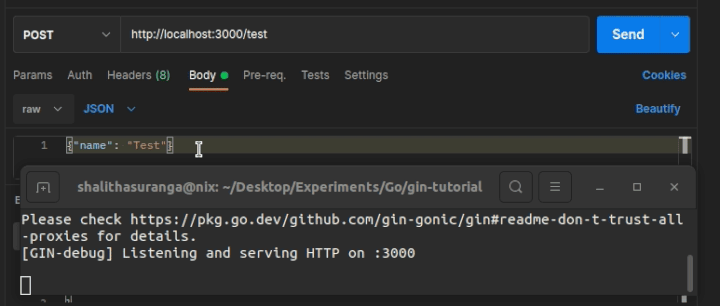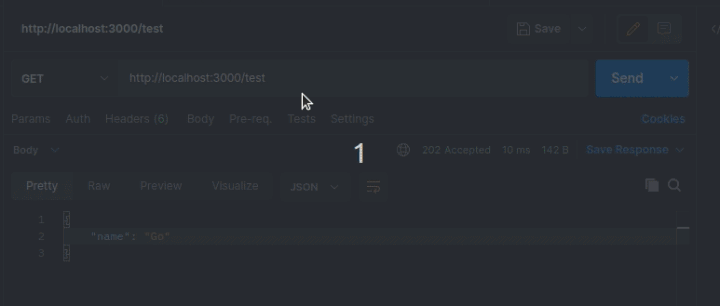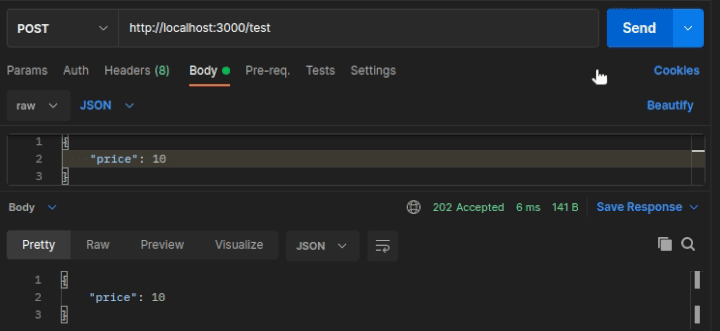Over the past few years, Go has become very popular for microservices. Gin is a web framework for Go that focuses on performance and productivity and features Martini-like APIs.

In this tutorial, we’ll show you how to use Gin’s binding. We’ll walk you through request payload validation, writing custom validation using reflection and the validator module, and building custom bindings for various formats, such as TOML, etc.
Gin binding is an awesome de-serialization library. It supports JSON, XML, query parameter, and more out of the box and comes with a built-in validation framework.
Gin bindings are used to serialize JSON, XML, path parameters, form data, etc. to structs and maps. It also has a baked-in validation framework with complex validations.
Gin supports various formats by providing struct tags. For example, the uri tag is used to serialize path parameters:
package main
import (
"fmt"
"github.com/gin-gonic/gin"
"net/http"
)
type Body struct {
// json tag to de-serialize json body
Name string `json:"name"`
}
func main() {
engine:=gin.New()
engine.POST("/test", func(context *gin.Context) {
body:=Body{}
// using BindJson method to serialize body with struct
if err:=context.BindJSON(&body);err!=nil{
context.AbortWithError(http.StatusBadRequest,err)
return
}
fmt.Println(body)
context.JSON(http.StatusAccepted,&body)
})
engine.Run(":3000")
}
The above code snippet binds JSON payloads coming from the POST /test endpoint to the body struct instance. We can test it with the Postman tool, as shown below.

BindJSON reads the body buffer to de-serialize it to a struct. BindJSON cannot be called on the same context twice because it flushes the body buffer.
If you want to de-serialize the body to two different structs, use ShouldBindBodyWith to copy the body buffer and add it to context.
if err:=context.ShouldBindBodyWith(&body,binding.JSON);err!=nil{
context.AbortWithError(http.StatusBadRequest,err)
return
}
In the same way, the XML body and path parameters are mapped to structs.
package main
import (
"fmt"
"github.com/gin-gonic/gin"
"net/http"
)
// path paramter with name details will mapped to Details
type URI struct {
Details string `json:"name" uri:"details"`
}
func main() {
engine:=gin.New()
// adding path params to router
engine.GET("/test/:details", func(context *gin.Context) {
uri:=URI{}
// binding to URI
if err:=context.BindUri(&uri);err!=nil{
context.AbortWithError(http.StatusBadRequest,err)
return
}
fmt.Println(uri)
context.JSON(http.StatusAccepted,&uri)
})
engine.Run(":3000")
}
The example above is a basic use case for binding to de-serialize the body, query, and path parameters. The above endpoint produces a serialized JSON object by binding path params, as shown below.

Gin uses the validator package internally for validations. This package validator provides an extensive set of inbuilt validations, including required, type validation, and string validation.
Validations are added to structs via the binding struct tag:
type URI struct {
Details string `json:"name" uri:"details" binding:"required"`
}
The validator package also supports more complex validation, such as len ,max, and min.
Let’s use Gin’s inbuilt validation syntax for several practical scenarios.
We often have to validate phone numbers, email addresses, and country codes in our web application backends while we are processing contact details. Look at the following example struct:
type Body struct {
FirstName string `json:"firstName" binding:"required"`
LastName string `json:"lastName" binding:"required"`
Email string `json:"email" binding:"required,email"`
Phone string `json:"phone" binding:"required,e164"`
CountryCode string `json:"countryCode" binding:"required,iso3166_1_alpha2"`
}
The above struct tags validate email with a generic regular expression, phone with the international E.164 standard, and country-code with the ISO-3166–1 two-letter standard. For example, it accepts the following sample JSON payload for the binding process:
{
"firstName": "John",
"lastName": "Mark",
"email": "[email protected]",
"phone": "+11234567890",
"countryCode": "US"
}
The validator package offers postal code validation support too. For example, you can validate a British postal code with the following syntax.
type Body struct {
PostCode string `json:"postCode" binding:"required,postcode_iso3166_alpha2=GB"`
}
Earlier, we used some standard formats for validation. But, we often have to define custom formats for validating domain-specific user inputs. For example, you can use struct tags to validate a custom product code format. The validator package offers many helpful string validator helpers.
Assume that you need to validate a ten-letter product code starting with the PC string prefix. For this scenario, you can use the startswith tag with the len tag:
type Body struct {
ProductCode string `json:"productCode" binding:"required,startswith=PC,len=10"`
}
The above struct definition accepts the following JSON payload for binding:
{
"productCode": "PC00001120"
}
Here are some other string validation helpers that we often need:
| Tag | Description | Usage Example |
uppercase |
Accepts only uppercase letters | binding:"uppercase" |
lowercase |
Accepts only lowercase letters | binding:"lowercase" |
contains |
Accepts only strings that contain a specific string segment. | binding:"contains=key" |
alphanum |
Accepts only alphanumeric characters (English letters and numerical digits). Rejects strings that contain special characters. | binding:"alphanum" |
alpha |
Accepts only English letters | binding:"alpha" |
endswith |
Accepts only strings that end with a specific sequence of characters | binding:"endswith=." |
The validator package offers several tags for comparison — you can use these tags to compare a particular field with another field, or hardcoded value, as shown below:
type Body struct {
Width int `json:"width" binding:"required,gte=1,lte=100,gtfield=Height"`
Height int `json:"height" binding:"required,gte=1,lte=100"`
}
The above code binds JSON payloads into the above struct definition based on the following constraints:
Height valueGin offers the time_format struct tag to validate date and time formats. You can combine the time_format tag with validation helper tags for date and time validation.
For example, you can validate a date range form input with the following struct definition:
type Body struct {
StartDate time.Time `form:"start_date" binding:"required,ltefield=EndDate" time_format:"2006-01-02"`
EndDate time.Time `form:"end_date" binding:"required" time_format:"2006-01-02"`
}
You can provide any valid Go date format via the time_format tag. For example, 2006-01-02 15:04:05 will accept a date-time input based on the yyyy-mm-dd hh:mm:ss format.
Nested structs and arrays are also validated recursively.
type User struct {
Name string `json:"name" binding:"required,min=3"`
Age uint `json:"age" binding:"required,min=18"`
Comments []*Comment `json:"comments" binding:"required"`
}
type Comment struct {
Text string `json:"text" binding:"required,max=255"`
Type string `json:"type" binding:"required,oneof=post nested"`
}
Gin comes with many inbuilt validations and validation helper tags; you can find an exhaustive list on GitHub.
In previous examples, we used the AbortWithError function to send an HTTP error code back to the client, but we didn’t send a meaningful error message. So, we can improve endpoints by sending a meaningful validation error message as a JSON output:
package main
import (
"github.com/gin-gonic/gin"
"net/http"
)
type Body struct {
Price uint `json:"price" binding:"required,gte=10,lte=1000"`
}
func main() {
engine:=gin.New()
engine.POST("/test", func(context *gin.Context) {
body:=Body{}
if err:=context.ShouldBindJSON(&body);err!=nil{
context.AbortWithStatusJSON(http.StatusBadRequest,
gin.H{
"error": "VALIDATEERR-1",
"message": "Invalid inputs. Please check your inputs"})
return
}
context.JSON(http.StatusAccepted,&body)
})
engine.Run(":3000")
}
Now, the above code uses the AbortWithStatusJSON function and returns a unique error code and message to the client, so the client can display a meaningful error message to the user.

Also, you can return the technical auto-generated error message, as shown below:
gin.H{
"error": "VALIDATEERR-1",
"message": err.Error()})
The above approaches give a too-generic error and a technical message respectively, so we can improve error responses further by returning a list of meaningful error messages with the following code:
package main
import (
"github.com/gin-gonic/gin"
"github.com/go-playground/validator/v10"
"net/http"
"errors"
)
type Body struct {
Product string `json:"product" binding:"required,alpha"`
Price uint `json:"price" binding:"required,gte=10,lte=1000"`
}
type ErrorMsg struct {
Field string `json:"field"`
Message string `json:"message"`
}
func getErrorMsg(fe validator.FieldError) string {
switch fe.Tag() {
case "required":
return "This field is required"
case "lte":
return "Should be less than " + fe.Param()
case "gte":
return "Should be greater than " + fe.Param()
}
return "Unknown error"
}
func main() {
engine:=gin.New()
engine.POST("/test", func(context *gin.Context) {
body:=Body{}
if err:=context.ShouldBindJSON(&body);err!=nil{
var ve validator.ValidationErrors
if errors.As(err, &ve) {
out := make([]ErrorMsg, len(ve))
for i, fe := range ve {
out[i] = ErrorMsg{fe.Field(), getErrorMsg(fe)}
}
context.AbortWithStatusJSON(http.StatusBadRequest, gin.H{"errors": out})
}
return
}
context.JSON(http.StatusAccepted,&body)
})
engine.Run(":3000")
}
Now, we have clear and meaningful error messages based on validation tag names. For example, if you send the following JSON payload to the API:
{
"price": 5
}
You will get the following output:
{
"errors": [
{
"field": "Product",
"message": "This field is required"
},
{
"field": "Price",
"message": "Should be greater than 10"
}
]
}
Now you can display a detailed and specific error message for each field by using the above errors list.
Not all use cases are well-suited to built-in Gin validations. For this reason, Gin provides methods to add custom validations.
The reflect package is used during the validation process to figure out types and the value of struct fields at runtime.
To create a new binding, you have to register a validation with a function that performs the validation.
// getting the validation engine and type casting it.
if v, ok := binding.Validator.Engine().(*validator.Validate); ok {
// registering validation for nontoneof
v.RegisterValidation("notoneof", func(fl validator.FieldLevel) bool {
// split values using ` `. eg. notoneof=bob rob job
match:=strings.Split(fl.Param()," ")
// convert field value to string
value:=fl.Field().String()
for _,s:=range match {
// match value with struct filed tag
if s==value {
return false
}
}
return true
})
}
You can access the validation engine using the binding package for adding custom validators. The Validator variable is exported. Validator provides the Engine method, which returns the validation engine.
The RegisterValidation method on the engine takes a name and function that returns whether the field is valid or not.
You can access parameters passed to the validator using the Param method.
The Field method returns the value of the field in a struct. The value can be typecast to various data types.
validator.FieldLevel has access to a whole struct. You can also access different keys of a parent struct.
FieldLevel has a Top method that returns a reflect.Value type of the struct. That can be used to access the field in a struct.
For example, you can create a validation where two fields can’t have the same value using reflect.Value.
v.RegisterValidation("unique", func(fl validator.FieldLevel) bool {
// get the fields which need to be unique
match:=strings.Split(fl.Param()," ")
// value of the field
value:=fl.Field().String()
for _,s:=range match {
// access to struct and getting value by field name
fs:=fl.Top().FieldByName(s)
// check only for string validation
if fs.Kind() == reflect.String {
// check value of both fields
if value==fs.String() {
return false
}
}
}
return true
})
The above example only checks for string values, but you can easily modify it for all data types:
type ExampleStruct struct {
Name string `json:"name" uri:"name" binding:"notoneof=bob rob job"`
LastName string `json:"last_name" binding:"unique=Name"`
}
In some cases, the client and server use different formats to interchange data. For example, instead of JSON or XML, TOML might be used as the body for a request.
For cases like this, Gin provides a plug-and-play method for changing the body parser.
Every binding needs to implement this interface. The Name method returns a binding name and the Bind methods parse the request body:
type Binding interface {
Name() string
Bind(*http.Request, interface{}) error
}
Here’s an example of binding:
type Toml struct {
}
// return the name of binding
func (t Toml) Name() string {
return "toml"
}
// parse request
func (t Toml) Bind(request *http.Request, i interface{}) error {
// using go-toml package
tD:= toml.NewDecoder(request.Body)
// decoding the interface
return tD.Decode(i)
}
Usage example:
engine.POST("/Toml", func(context *gin.Context) {
uri:= URI{}
if err:=context.MustBindWith(&uri, Toml{});err!=nil{
context.AbortWithError(http.StatusBadRequest,err)
return
}
context.JSON(200,uri)
})
Implementing BindBody to use ShouldBindBodyWith:
func (t Toml) BindBody(bytes []byte, i interface{}) error {
return toml.Unmarshal(bytes,i)
}
Usage example:
engine.POST("/Toml", func(context *gin.Context) {
uri:= URI{}
if err:=context.ShouldBindBodyWith(&uri, Toml{});err!=nil{
context.AbortWithError(http.StatusBadRequest,err)
return
}
context.JSON(200,uri)
})
In this tutorial, we covered Gin binding, various built-in validators, and some more advanced use cases. We also covered how to build a custom binding using various interfaces provided by the Gin library. Finally, we build some custom validators using advanced reflection and the validator package. You can use these building blocks to build various HTTP body parsers.
Install LogRocket via npm or script tag. LogRocket.init() must be called client-side, not
server-side
$ npm i --save logrocket
// Code:
import LogRocket from 'logrocket';
LogRocket.init('app/id');
// Add to your HTML:
<script src="https://cdn.lr-ingest.com/LogRocket.min.js"></script>
<script>window.LogRocket && window.LogRocket.init('app/id');</script>
Would you be interested in joining LogRocket's developer community?
Join LogRocket’s Content Advisory Board. You’ll help inform the type of content we create and get access to exclusive meetups, social accreditation, and swag.
Sign up now
Not sure if low-code is right for your next project? This guide breaks down when to use it, when to avoid it, and how to make the right call.

Compare Firebase Studio, Lovable, and Replit for AI-powered app building. Find the best tool for your project needs.

Discover how to use Gemini CLI, Google’s new open-source AI agent that brings Gemini directly to your terminal.

This article explores several proven patterns for writing safer, cleaner, and more readable code in React and TypeScript.
One Reply to "Gin binding in Go: A tutorial with examples"
Great post! Very helpful. Nitpick: BindJSON is used to deserialize json to struct and not really serialize as mentioned many a time in the post.